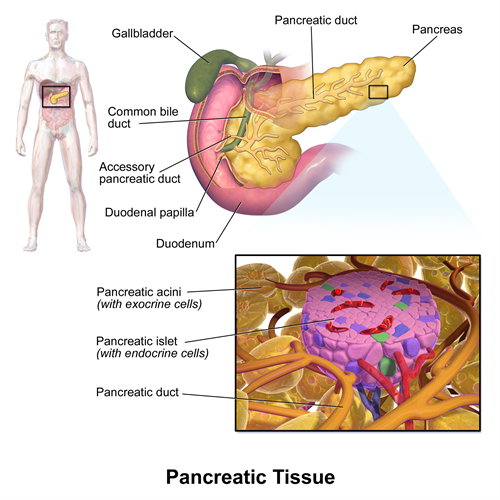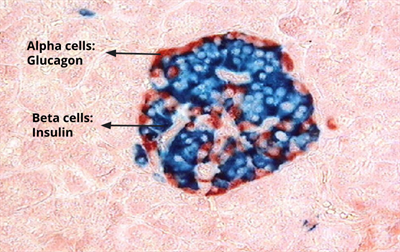PDF chapter test TRY NOW
The pancreas is an elongated, yellowish gland that lies inferior to the stomach in a loop of the stomach and duodenum. It functions as an exocrine and an endocrine gland.
The exocrine pancreas secretes pancreatic digestive juice, which plays a role in digestion, so the pancreas is termed as heterocrine gland.
The pancreas consists of acinar cells, which is the functional unit of the exocrine pancreas. Acinar cells synthesis, store and also secrete the digestive enzymes.

Pancreas - The heterocrine gland
The endocrine part of the pancreas is made up of a group of cells called Islets of Langerhans. They produce endocrine secretions or hormones. The Islets of Langerhans consists of four types of cells which include:
1. Alpha cells or A-cells
2. Beta cells or B-cells
3. Delta cells or D-cells
4. Pancreatic polypeptide cells or PP cells or F-cells.
The alpha cells are usually present towards the periphery of the islet, and the beta cells are usually located towards the middle of the islet. The delta cells and F-cells are found scatteredand secrete somatostatin and pancreatic polypeptides, respectively.
Hormones of the pancreas:

Islets of Langerhans - alpha and beta cells
1. Glucagon - It is secreted by the alpha cells. It stimulates the liver to convert glycogen into glucose.
2. Insulin - It is secreted by the beta cells. It has the opposite function of glucagon. The insulin converts glucose into glycogen in the liver as well as muscles.
3. Somatostatin (SS) - It is secreted by the delta cells of the islet.
4. Pancreatic polypeptide (PP) - It is secreted by the F-cells or PP cells of the islet.
Important!
Human insulin was first discovered by Fredrick Banting, Charles Best and MacLeod in the year 1921. Insulin was first used on 11th January 1922 to treat diabetes.
Functions of pancreatic hormones:
A balance between the hormones insulin and glucagon is necessary to maintain the levels of blood glucose.
Insulin:
- Insulin converts glucose to glycogen which is stored in the liver and skeletal muscles.
- It promotes the transport of glucose into the cells.
- Insulin promotes the synthesis of protein from amino acids in tissues.
- It decreases the concentration of glucose in the blood.
- It increases the synthesis of fat in the adipose tissues.
Glucagon:
- Glucagon helps in the breakdown of glycogen to glucose in the liver.
- Glucagon increases blood glucose levels.
Dysfunctions of the pancreas:
1. Diabetes mellitus or hyperglycemia:
The most common disorder of the pancreas is diabetes mellitus. It is caused due to the deficiency of insulin. Diabetes mellitus is of two forms:
a. Insulin-dependent diabetes mellitus
b. Non-insulin-dependent diabetes mellitus
Diabetes mellitus is characterised by:
- Increase in blood glucose levels above the normal range (Hyperglycemia).
- Excretion of the excess glucose in the urine (Glycosuria).
- Frequent urination (Polyuria) and dehydration of body tissues.
- Excessive thirst (Polydipsia).
- Degradation of fat increases, producing ketone bodies (ketosis).
- Increase in appetite (Polyphagia).
2. Hypoglycemia:
Hypoglycemia occurs when the glucose levels in the blood fall below normal. It is either caused due to excess insulin or deficiency of glucagon. Symptoms of hypoglycemia include weakness, irritability, profuse sweating, unconsciousness and convulsions.

Hyperglycemia and hypoglycemia
Reference:
https://upload.wikimedia.org/wikipedia/commons/thumb/6/6e/Blausen_0701_PancreaticTissue.png/2048px-Blausen_0701_PancreaticTissue.png
https://upload.wikimedia.org/wikipedia/commons/thumb/0/05/Human_pancreatic_islet.jpg/1024px-Human_pancreatic_islet.jpg
https://upload.wikimedia.org/wikipedia/commons/d/d6/1822_The_Homostatic_Regulation_of_Blood_Glucose_Levels.jpg
